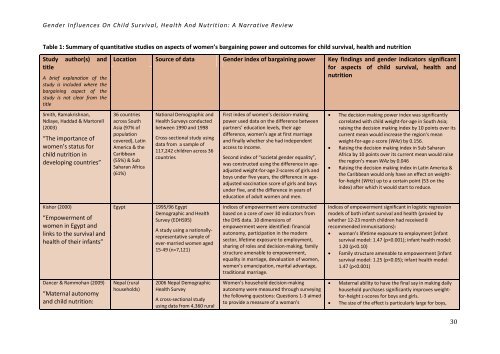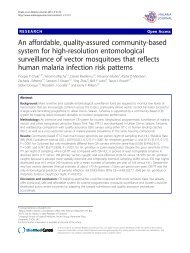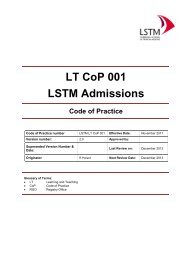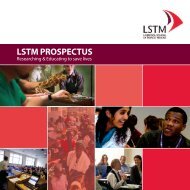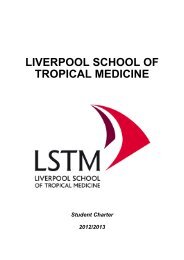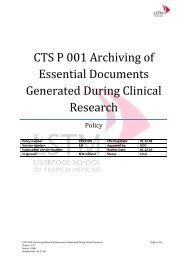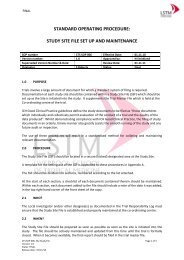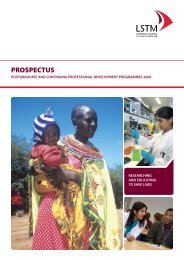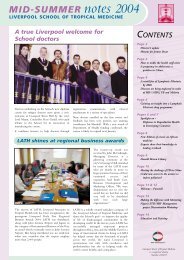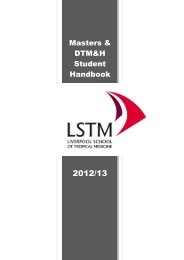Gender influences on child survival, health and nutrition: a ... - Unicef
Gender influences on child survival, health and nutrition: a ... - Unicef
Gender influences on child survival, health and nutrition: a ... - Unicef
Create successful ePaper yourself
Turn your PDF publications into a flip-book with our unique Google optimized e-Paper software.
<str<strong>on</strong>g>Gender</str<strong>on</strong>g> Influences On Child Survival, Health And Nutriti<strong>on</strong>: A Narrative Review<br />
Table 1: Summary of quantitative studies <strong>on</strong> aspects of women’s bargaining power <strong>and</strong> outcomes for <strong>child</strong> <strong>survival</strong>, <strong>health</strong> <strong>and</strong> nutriti<strong>on</strong><br />
Study author(s) <strong>and</strong><br />
title<br />
A brief explanati<strong>on</strong> of the<br />
study is included where the<br />
bargaining aspect of the<br />
study is not clear from the<br />
title<br />
Smith, Ramakrishnan,<br />
Ndiaye, Haddad & Martorell<br />
(2003)<br />
“The importance of<br />
women’s status for<br />
<strong>child</strong> nutriti<strong>on</strong> in<br />
developing countries”<br />
Kishor (2000)<br />
“Empowerment of<br />
women in Egypt <strong>and</strong><br />
links to the <strong>survival</strong> <strong>and</strong><br />
<strong>health</strong> of their infants”<br />
Dancer & Rammohan (2009)<br />
“Maternal aut<strong>on</strong>omy<br />
<strong>and</strong> <strong>child</strong> nutriti<strong>on</strong>:<br />
Locati<strong>on</strong> Source of data <str<strong>on</strong>g>Gender</str<strong>on</strong>g> index of bargaining power Key findings <strong>and</strong> gender indicators significant<br />
for aspects of <strong>child</strong> <strong>survival</strong>, <strong>health</strong> <strong>and</strong><br />
nutriti<strong>on</strong><br />
36 countries<br />
across South<br />
Asia (97% of<br />
populati<strong>on</strong><br />
covered), Latin<br />
America & the<br />
Caribbean<br />
(55%) & Sub<br />
Saharan Africa<br />
(61%)<br />
Egypt<br />
Nepal (rural<br />
households)<br />
Nati<strong>on</strong>al Demographic <strong>and</strong><br />
Health Surveys c<strong>on</strong>ducted<br />
between 1990 <strong>and</strong> 1998<br />
Cross-secti<strong>on</strong>al study using<br />
data from a sample of<br />
117,242 <strong>child</strong>ren across 36<br />
countries<br />
1995/96 Egypt<br />
Demographic <strong>and</strong> Health<br />
Survey (EDHS95)<br />
A study using a nati<strong>on</strong>allyrepresentative<br />
sample of<br />
ever-married women aged<br />
15-49 (n=7,121)<br />
2006 Nepal Demographic<br />
Health Survey<br />
A cross-secti<strong>on</strong>al study<br />
using data from 4,360 rural<br />
First index of women’s decisi<strong>on</strong>-making<br />
power used data <strong>on</strong> the difference between<br />
partners’ educati<strong>on</strong> levels, their age<br />
difference, women’s age at first marriage<br />
<strong>and</strong> finally whether she had independent<br />
access to income.<br />
Sec<strong>on</strong>d index of “societal gender equality”,<br />
was c<strong>on</strong>structed using the difference in ageadjusted<br />
weight-for-age Z-scores of girls <strong>and</strong><br />
boys under five years, the difference in ageadjusted<br />
vaccinati<strong>on</strong> score of girls <strong>and</strong> boys<br />
under five, <strong>and</strong> the difference in years of<br />
educati<strong>on</strong> of adult women <strong>and</strong> men.<br />
Indices of empowerment were c<strong>on</strong>structed<br />
based <strong>on</strong> a core of over 30 indicators from<br />
the DHS data. 10 dimensi<strong>on</strong>s of<br />
empowerment were identified: financial<br />
aut<strong>on</strong>omy, participati<strong>on</strong> in the modern<br />
sector, lifetime exposure to employment,<br />
sharing of roles <strong>and</strong> decisi<strong>on</strong>-making, family<br />
structure amenable to empowerment,<br />
equality in marriage, devaluati<strong>on</strong> of women,<br />
women’s emancipati<strong>on</strong>, marital advantage,<br />
traditi<strong>on</strong>al marriage.<br />
Women’s household decisi<strong>on</strong>-making<br />
aut<strong>on</strong>omy were measured through surveying<br />
the following questi<strong>on</strong>s: Questi<strong>on</strong>s 1-3 aimed<br />
to provide a measure of a woman’s<br />
<br />
<br />
<br />
The decisi<strong>on</strong> making power index was significantly<br />
correlated with <strong>child</strong> weight-for-age in South Asia;<br />
raising the decisi<strong>on</strong> making index by 10 points over its<br />
current mean would increase the regi<strong>on</strong>’s mean<br />
weight-for-age z-score (WAz) by 0.156.<br />
Raising the decisi<strong>on</strong> making index in Sub Saharan<br />
Africa by 10 points over its current mean would raise<br />
the regi<strong>on</strong>’s mean WAz by 0.046<br />
Raising the decisi<strong>on</strong> making index in Latin America &<br />
the Caribbean would <strong>on</strong>ly have an effect <strong>on</strong> weightfor-height<br />
(WHz) up to a certain point (53 <strong>on</strong> the<br />
index) after which it would start to reduce.<br />
Indices of empowerment significant in logistic regressi<strong>on</strong><br />
models of both infant <strong>survival</strong> <strong>and</strong> <strong>health</strong> (proxied by<br />
whether 12-23 m<strong>on</strong>th <strong>child</strong>ren had received 8<br />
recommended immunisati<strong>on</strong>s):<br />
woman’s lifetime exposure to employment [infant<br />
<strong>survival</strong> model: 1.47 (p


